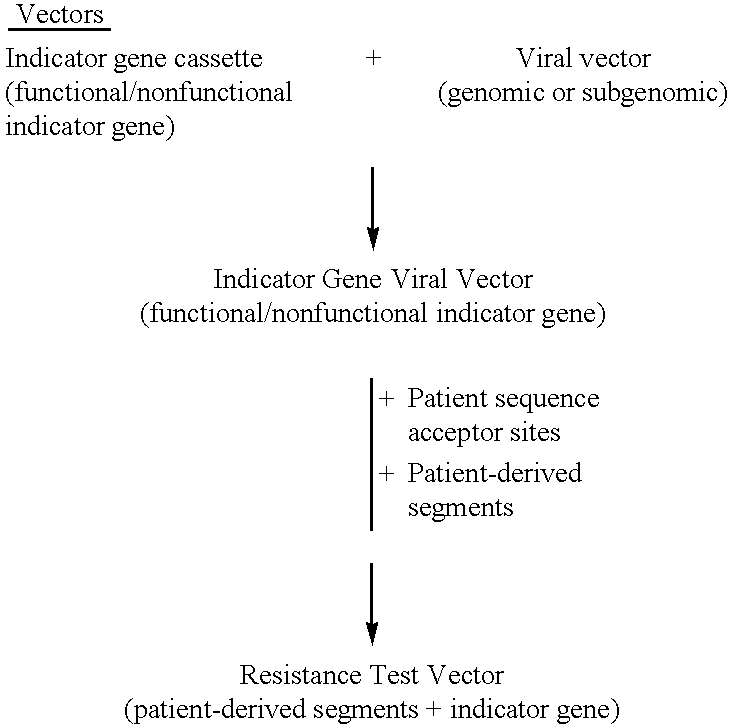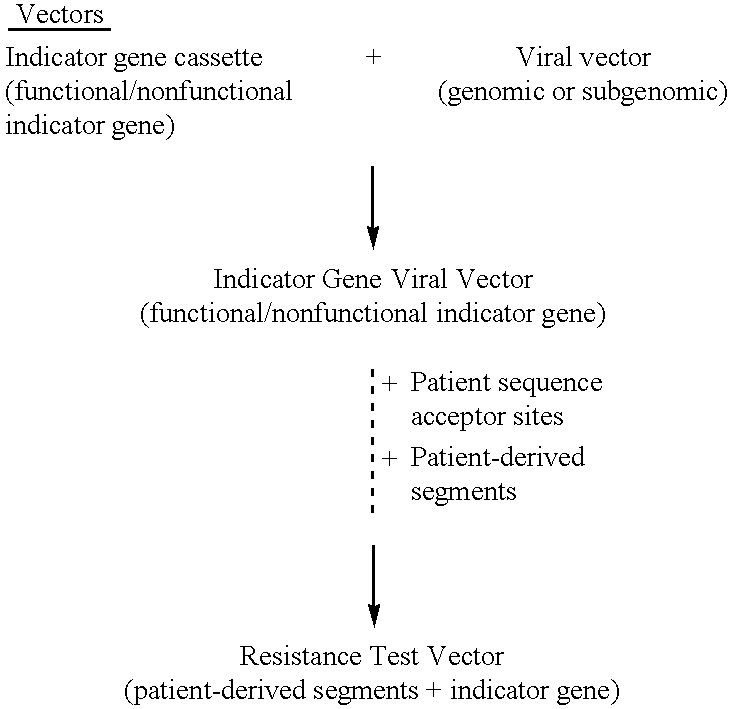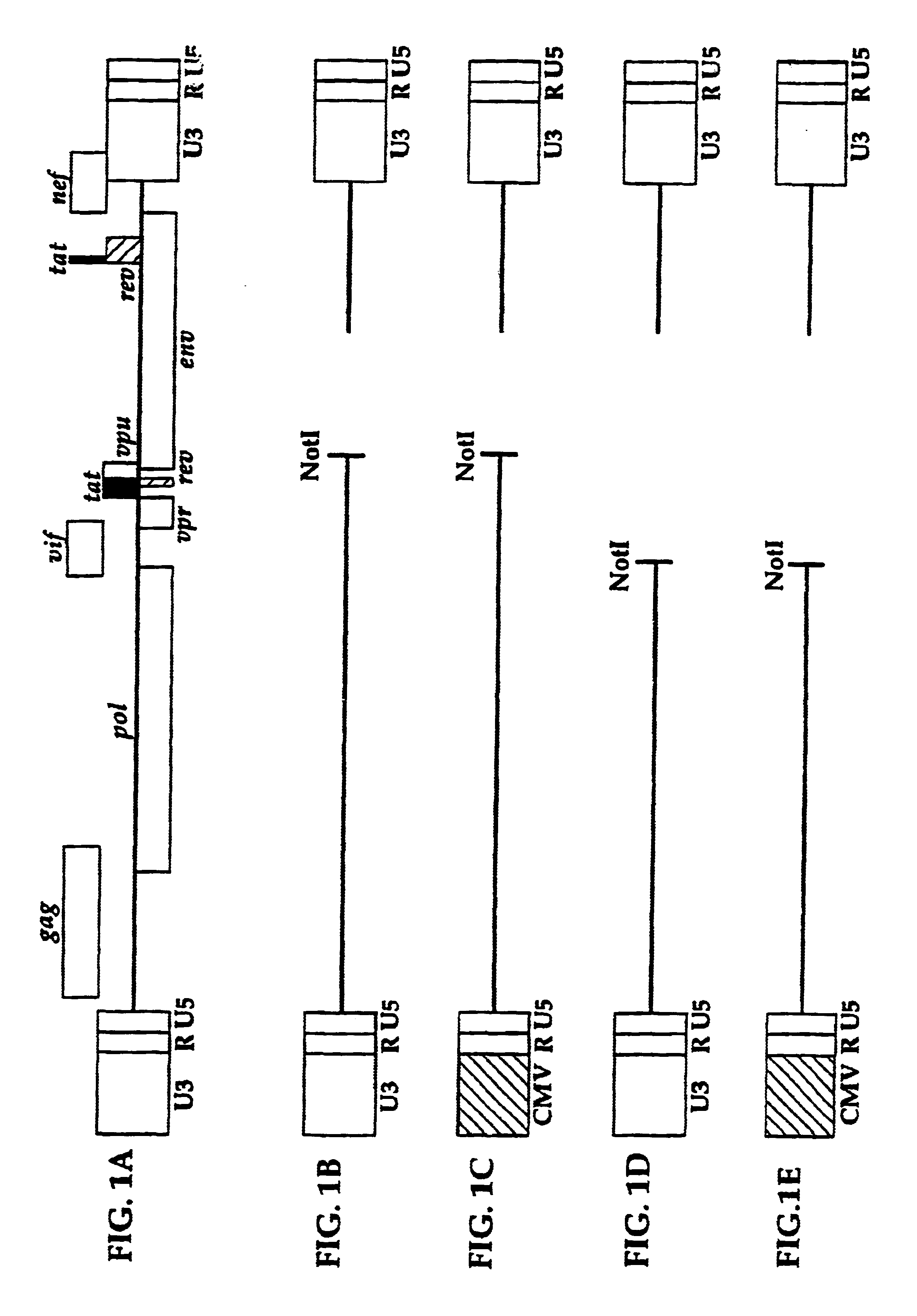Compositions and methods for determining anti-viral drug susceptibility and resistance and anti-viral drug screening
a technology of susceptibility and resistance, which is applied in the direction of viruses/bacteriophages, instruments, artificial cell constructs, etc., can solve the problems of increasing the number of aids cases, the design of antiviral compounds is not straightforward, and the susceptibility of viral drug resistance is substantial, so as to improve the susceptibility and resistance of drugs, the effect of less effective and more affordabl
- Summary
- Abstract
- Description
- Claims
- Application Information
AI Technical Summary
Benefits of technology
Problems solved by technology
Method used
Image
Examples
example 1
HCV Drug Susceptibility and Resistance Test Using Resistance Test Vectors Comprising Patient-Derived Segment(s) and a Functional Indicator Gene Fused to the HCV Polyprotein
Indicator Gene Viral Vector—Construction
[0535]The indicator gene viral vector (IGVV) pXHCV-luc was designed using HCV genomic viral vectors containing a functional indicator gene fused to the HCV polyprotein. The IGVV is constructed by inserting the open reading frame for the indicator gene in a cDNA construct containing the entire HCV genome producing an in-frame fusion protein. The IGVV also contains all the cis-acting regulatory elements in the 5′ and 3′ untranslated regions (UTRs) required for replication, transcription, and translation of the HCV RNA. In one embodiment, the luciferise open reading frame is placed immediately downstream of the NS5 coding region, with a spacer region containing the recognition sequence for the NS3 / 4A protease (FIG. 17A). An example of such a cleavage site is TEDVVCC-SMSYTWT, re...
example 2
HCV Drug Susceptibility and Resistance Test Using Resistance Test Vectors Comprising Patient-Derived Segment(s) and a Functional Indicator Gene Expressed from an Internal Ribosomal Initiation Sequence
Indicator Gene Viral Vector—Construction
[0549]Initiation of translation of the HCV polyprotein occurs via a cap-independent internal initiation mechanism. The 5′ end of the viral RNA, comprising the untranslated region (UTR) and the first 369 nucleotides of the C open reading frame, contains a sequence and / or structure which directs cap-independent translation initiation (Tsukiyama-Kohara et al, J Virol. 66:1476, 1992; Wang et al, J Virol. 67:3338, 1993; Lu and Wimmer, PNAS 93:1412, 1996). Other viruses such as poliovirus (PV) (Pelletier and Sonenberg (1988), Nature, 334, 320-325), encephalomyocarditis virus (EMCV) (Jang et al. (1989), J. Virol. 63, 1651-1660), rhinovirus (RV) (Rohll et al. (1994), J. Virol. 68, 4384-4391), hepatitis A virus (HAV) (Brown et al. (1994), J. Virol. 68, 106...
example 3
HCV Drug Susceptibility and Resistance Test Using Resistance Test Vectors Comprising Patient-Derived Segment(s) and a Functional Indicator Gene Expressed from a Replication Defective Minigenome
Indicator Gene Viral Vector—Construction
[0555]HCV replication-dependent expression of an indicator gene is achieved by constructing an artificial HCV subgenomic viral vector, or “minigenome”, consisting of the HCV 5′ UTR and, if required, an amino-terminal portion of the C open reading frame (required as part of the IRES), an IG, for example luciferase, and the HCV 3′ UTR (see FIG. 19). Luciferase is produced bearing an N-terminal extension derived from the C open reading frame; alternatively, the ATG at the beginning of the C open reading frame is mutated so that translation begins at the ATG of luciferase. The 5′ UTR plus the N-terminus of C and 3′ UTR contain all cis-acting signals required for translation, replication, and packaging of the RNA. The luciferase minigenome is co-transfected, ...
PUM
| Property | Measurement | Unit |
|---|---|---|
| Electrical resistance | aaaaa | aaaaa |
| Cell angle | aaaaa | aaaaa |
| Biological properties | aaaaa | aaaaa |
Abstract
Description
Claims
Application Information
 Login to View More
Login to View More - R&D
- Intellectual Property
- Life Sciences
- Materials
- Tech Scout
- Unparalleled Data Quality
- Higher Quality Content
- 60% Fewer Hallucinations
Browse by: Latest US Patents, China's latest patents, Technical Efficacy Thesaurus, Application Domain, Technology Topic, Popular Technical Reports.
© 2025 PatSnap. All rights reserved.Legal|Privacy policy|Modern Slavery Act Transparency Statement|Sitemap|About US| Contact US: help@patsnap.com



